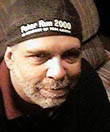|
|
This topic comprises 2 pages: 1 2
|
|
Author
|
Topic: China Markers
|
|
|
|
|
|
|
|
|
Russ Kress
Expert Film Handler

Posts: 202
From: Charleston, WV, USA
Registered: May 2000
|
 posted 06-22-2000 11:32 PM
posted 06-22-2000 11:32 PM





We use clear tape on repairs and zebra tape on reel changes.Since polyester film doesn't break, I have found that my guys will use clear tape at the reel changes as well. When the only splices present are reel change splices, there isn't any confusion at break-down. We also use editing gloves (cotton). Is this neccessary when we treat all new prints with Film Guard on their first two runs? I seem to recall somewhere where someone didn't like the gloves, but I can't remember the reason. While I'm at it, we also use Kodak PTRs on every performance where a media cleaner is not in use. We have two media cleaners and eleven screens. Can the PTRs pick up dust from Film Guard treated prints? Russ
| IP: Logged
|
|
Brad Miller
Administrator

Posts: 17775
From: Plano, TX (36.2 miles NW of Rockwall)
Registered: May 99
|
 posted 06-23-2000 03:57 AM
posted 06-23-2000 03:57 AM




Most people don't use gloves because a better splice can be made if you aren't fumbling through a pair of gloves. Also, frequently the cotton fibers get trapped in the splices and make for a nasty looking splice. I don't use them and so long as you don't go running your fingers over the picture area, don't feel they are necessary. Inspecting prints is also far easier without gloves.Yes, PTRs can pick up dust/dirt from FG prints. I also must agree with Gordon. The Eprad marker does a fantastic job. Their applicator also makes it virtually impossible for it to disturb the SDDS track (but then again who cares about that track anyway, right)?  Still, why not just put a piece of tape on the reels with a line drawn on the tape at the "full level" and use that for breaking down?
| IP: Logged
|
|
|
|
|
|
|
|
|
|
|
|
|
|
|
|
|
|
Rick Long
Jedi Master Film Handler
Posts: 759
From: Toronto, Ontario, Canada
Registered: Nov 1999
|
 posted 07-15-2000 10:11 PM
posted 07-15-2000 10:11 PM




Okay let's talk real-life here. When you are a manager/projectionist dealing with cash-outs, stock control, and 6 films to make-up for the next day, you are NOT going to spend your valuable time looking for where you left the damn Eprad cue marker! You are going to look for the most expedient method possible of marking the reel changes, be it china marker or paint stick. C'mon guys, this is the real world today. Let's start a thread on the deterioration of projection on-screen quality in the past decade.
| IP: Logged
|
|
|
|
All times are Central (GMT -6:00)
|
This topic comprises 2 pages: 1 2
|
Powered by Infopop Corporation
UBB.classicTM
6.3.1.2
The Film-Tech Forums are designed for various members related to the cinema industry to express their opinions, viewpoints and testimonials on various products, services and events based upon speculation, personal knowledge and factual information through use, therefore all views represented here allow no liability upon the publishers of this web site and the owners of said views assume no liability for any ill will resulting from these postings. The posts made here are for educational as well as entertainment purposes and as such anyone viewing this portion of the website must accept these views as statements of the author of that opinion
and agrees to release the authors from any and all liability.
|

 Home
Home
 Products
Products
 Store
Store
 Forum
Forum
 Warehouse
Warehouse
 Contact Us
Contact Us




 Printer-friendly view of this topic
Printer-friendly view of this topic

















